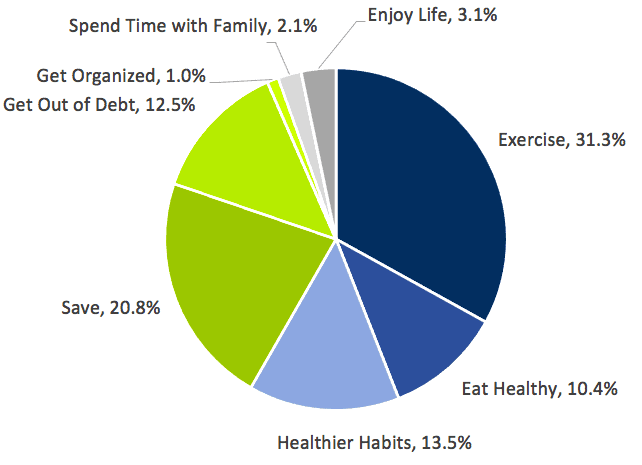How to Set Resolutions that Last
According to US News, 80% of New Years’ resolutions fail by February.[1] Many of us have experienced the excitement of setting goals, followed by the disappointment of failing to reach them. Similarly, most of us wonder why this is the case. Why do we continually set goals we either can’t or won’t accomplish? Why do we fail to live up to our good intentions? To answer these questions, let’s take a look at the types of resolutions we’re making, why those resolutions fail, and how we can do a better job of setting resolutions that last.
Personal and Professional Development
A recent study done by the University of Chicago reported that 55% of New Years’ resolutions are health related, 34% are work related, and 5% are social goals (Figure 1).[2] In other words, most New Years’ resolutions revolve around personal and professional development. This makes sense, given that we live in a world that promotes ‘being your best self’ and always striving to live life to your full potential. These goals sound like they should be good for us. So, why are so many abandoned within just a few weeks?

Why Resolutions Fail
In the research described above, participants believed that enjoyment and importance would predict how successful they were at accomplishing their goals. This explains why we often set ambitious goals aimed at bettering all aspects of life. Contrary to this belief, however, researchers found that only enjoyment predicted long-term goal attainment. A goal could be worthwhile, sensible, and desirable, but if the process of striving for the goal is tiring, difficult, and draining, most people will not persist. And this isn’t laziness or a lack of discipline, it’s human nature. We make a fundamental psychological error by assuming that we will stick to goals only because they are important,[3] ignoring the critical role that enjoyment plays in gaining valuable rewards.
In fact, research done by Woolley and Fishbach found that gaining immediate rewards predicted persistence in New Year’s resolutions while gaining delayed rewards alone did not.[4] Immediate rewards can be external, such as money, points, discounts, or credentials. However, progression towards goals can also provide immediate internal rewards, such as a sense of enjoyment, pride, or accomplishment when reaching milestones. One of the easiest ways to create that sense of accomplishment is by outlining specific and measurable action plans. This allows you to see progress and experience a sense of accomplishment at each stage of the journey, rather than waiting for delayed gratification only once the goal is fully achieved.
How to Set Resolutions That Last
To set resolutions that last, make sure your action plan contains goals that are SMART: specific, measurable, attainable, relevant, and timely.
- SPECIFIC goals clearly define the task, making it more likely they will be accomplished. This includes identifying the what, when, where, and how often of your goal. By setting specific goals, you can more clearly define the behavior you hope to change. As a result, you are more likely to be successful.
- MEASURABLE goals contribute to your sense of accomplishment. By tracking and quantifying success, you will be able to experience accomplishment along the way, rather than only at the end. Setting measurable goals also allows you to monitor progress and make changes to the steps you’re taking to achieve those goals.
- ATTAINABLE goals are more likely to encourage perseverance. It is easier to maintain motivation when you know the end goal can be achieved.
- RELEVANT goals are aligned with your personal and professional ambitions. To set relevant goals, think of smaller goals you can set along the way. For example, if your goal is to improve work-life balance, set smaller goals. Examples include implementing an exercise routine, not answering emails from home, pursuing a hobby, or having weekly ‘meetings’ with friends or family. These goals can be staggered by week or by month, such that the cumulative effect (e.g. after half a year) is a significantly improved work-life balance.
- TIMELY goals ensure you can accomplish what you set out to do by the time it needs to be done. Make sure your timeline leaves room for flexibility, in case unforeseen circumstances prevent tasks from being accomplished by their ‘due date.’ Use timelines to create a sense of urgency, but take time to re-evaluate and update them as needed. Remember, maintaining flexibility will help you to stay on track with your goals, even when facing setbacks or challenges.
SIGMA Can Help
One of the best ways to set and achieve goals is to work with a coach. If you are interested in professional coaching services, SIGMA is here to help! Over the last 50 years we’ve worked with more than 8,500 private and public organizations to develop people potential and increase organizational effectiveness. We provide individual and group coaching services, as well as a host of assessments to guide your development efforts. We also offer custom consulting and succession planning services. To learn more about our solutions, contact us directly for more information.
[1] Mulvey, K. (January 3, 2017). 80% of New Year’s resolutions fail by February – here’s how to keep yours. Business Insider. Retrieved from https://www.businessinsider.com/new-years-resolutions-courses-2016-12.
[2] Persaud, R. & Bruggen, P. (December 31, 2017). Psychology Explains New Years Resolutions, Hits and Misses. PsychologyToday. Retrieved from https://www.psychologytoday.com/us/blog/slightly-blighty/201712/psychology-explains-new-year-resolutions-hits-and-misses.
[3] Ibid.
[4] Wolley, K. & Fishbach, A. (February 2017). Immediate Rewards Predict Adherence to Long-Term Goals. Personality and Social Psychology Bulletin, 43(2): 151-162